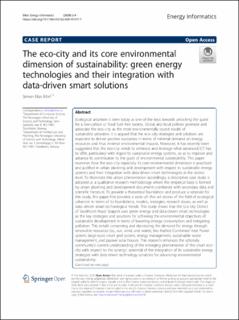| dc.contributor.author | Bibri, Simon Elias | |
| dc.date.accessioned | 2020-06-18T08:06:03Z | |
| dc.date.available | 2020-06-18T08:06:03Z | |
| dc.date.created | 2020-05-15T18:26:11Z | |
| dc.date.issued | 2020 | |
| dc.identifier.citation | Energy Informatics. 2020, 3 (4), | en_US |
| dc.identifier.issn | 2520-8942 | |
| dc.identifier.uri | https://hdl.handle.net/11250/2658570 | |
| dc.description.abstract | Ecological urbanism is seen today as one of the keys towards unlocking the quest for a low-carbon or fossil fuel–free society. Global and local policies promote and advocate the eco–city as the most environmentally sound model of sustainable urbanism. It is argued that the eco–city strategies and solutions are expected to deliver positive outcomes in terms of minimal demand on energy resources and thus minimal environmental impacts. Moreover, it has recently been suggested that the eco-city needs to embrace and leverage what advanced ICT has to offer, particularly with regard to sustainable energy systems, so as to improve and advance its contribution to the goals of environmental sustainability. This paper examines how the eco–city especially its core environmental dimension is practiced and justified in urban planning and development with respect to sustainable energy systems and their integration with data-driven smart technologies at the district level. To illuminate this urban phenomenon accordingly, a descriptive case study is adopted as a qualitative research methodology where the empirical basis is formed by urban planning and development documents combined with secondary data and scientific literature. To provide a theoretical foundation and produce a rationale for this study, this paper first provides a state–of–the–art review of the field of ecological urbanism in terms of its foundations, models, strategies, research issues, as well as data–driven smart technological trends. This study shows that the Eco-city District of Stockholm Royal Seaport uses green energy and data-driven smart technologies as the key strategies and solutions for achieving the environmental objectives of sustainable development in terms of lowering energy consumption and mitigating pollution. This entails conserving and decreasing the demand for energy through renewable resources (i.e., sun, wind, and water), bio–fuelled Combined Heat Power system, large-scale smart grid system, energy management, sustainable waste management, and passive solar houses. This research enhances the scholarly community’s current understanding of the emerging phenomenon of the smart eco-city with respect to the synergic potential of the integration of its sustainable energy strategies with data-driven technology solutions for advancing environmental sustainability. | en_US |
| dc.language.iso | eng | en_US |
| dc.publisher | John Wiley & Sons | en_US |
| dc.rights | Navngivelse 4.0 Internasjonal | * |
| dc.rights.uri | http://creativecommons.org/licenses/by/4.0/deed.no | * |
| dc.title | The Eco-city and Its Core Environmental Dimension of Sustainability: Green Energy Technologies and their Integration with Data-Driven Smart Solutions | en_US |
| dc.type | Peer reviewed | en_US |
| dc.type | Journal article | en_US |
| dc.description.version | publishedVersion | en_US |
| dc.source.volume | 3 | en_US |
| dc.source.journal | Energy Informatics | en_US |
| dc.source.issue | 4 | en_US |
| dc.identifier.doi | 10.1186/s42162-020-00107-7 | |
| dc.identifier.cristin | 1811304 | |
| dc.description.localcode | Open Access This article is licensed under a Creative Commons Attribution 4.0 International License, which permits use, sharing, adaptation, distribution and reproduction in any medium or format, as long as you give appropriate credit to the original author(s) and the source, provide a link to the Creative Commons licence, and indicate if changes were made. The images or other third party material in this article are included in the article's Creative Commons licence, unless indicated otherwise in a credit line to the material. If material is not included in the article's Creative Commons licence and your intended use is not permitted by statutory regulation or exceeds the permitted use, you will need to obtain permission directly from the copyright holder. To view a copy of this licence, visit http://creativecommons.org/licenses/by/4.0/. | en_US |
| cristin.ispublished | true | |
| cristin.fulltext | original | |
| cristin.qualitycode | 1 | |

